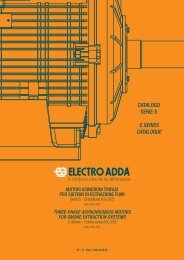Create successful ePaper yourself
Turn your PDF publications into a flip-book with our unique Google optimized e-Paper software.
semplice saldata di rame per ottenere un migliore<br />
rendimento e caratteristiche ottimali<br />
nell’alimentazione da inverter. L’impiego della<br />
gabbia semplice riduce significativamente le<br />
correnti armoniche ad alta frequenza presenti<br />
nelle gabbie rotore. L’impiego della gabbia<br />
semplice rende tali motori non idonei per<br />
avviamento da rete. A richiesta e possibile<br />
realizzare motori che possono essere alimentati<br />
sia da rete che da inverter<br />
• I motori possono essere forniti di encoder.<br />
I motori previsti per alimentazione a 690 V sono<br />
realizzati con un sistema di isolamento rinforzato<br />
(HPI system).<br />
I motori normali sono previsti con sistema di<br />
ventilazione IC411 (autoventilato) e sono idonei per<br />
applicazioni su macchine operatrici a coppia<br />
quadratica (pompe o ventilatori) e per<br />
funzionamento a coppia costante con frequenza di<br />
alimentazione minima di 30 Hz.<br />
A richiesta possono essere forniti motori con<br />
sistema di ventilazione IC416 (servoventilato) per<br />
applicazioni a coppia costante con frequenza<br />
minima di 5 Hz.<br />
I motori sono previsti per funzionare correttamente<br />
con un dV/dT massimo di 2000V/μsec.<br />
Nel caso di valori più elevati è consigliabile l’impiego<br />
di un adeguato filtro tra motore ed inverter per<br />
ridurre le sollecitazioni sul motore.<br />
Analogamente è necessario un filtro nel caso di<br />
eccessiva lunghezza dei cavi di alimentazione<br />
(distanza tra motore e inverter maggiore di 50 metri)<br />
La velocità massima, che i motori possono<br />
raggiungere è limitata dalle sollecitazione<br />
meccaniche che i motori possono sopportare senza<br />
danneggiamenti. Nella tabella dei dati tecnici nelle<br />
pagine seguenti è riportato tale limite per il<br />
funzionamento in servizio continuativo.<br />
Per brevi periodi è possibile superare tale limite di<br />
circa il 10% senza che si verifichino danneggiamenti<br />
dei cuscinetti.<br />
Nelle tabelle dei dati tecnici, sono riportate oltre alle<br />
caratteristiche elettriche, i limiti di velocità quale i<br />
motori possono funzionare erogando la potenza<br />
nominale con un margine tra la coppia massima e la<br />
coppia nominale del 50%.<br />
Oltre tale velocità e fino alla velocità massima<br />
ammessa i motori possono funzionare a potenza<br />
ridotta. Il valore di coppia massima (espresso in<br />
Nm) del motore in queste condizioni si ottiene<br />
moltiplicando il valore della coppia massima per il<br />
rapporto tra velocita nominale e velocità massima al<br />
quadrato.<br />
Occorre tener presente che aumentando la velocità<br />
di funzionamento aumenta anche il rumore emesso<br />
dal motore stesso, pertanto per aumenti superiori al<br />
20% della velocità nominale si consiglia l’impiego di<br />
motori servoventilati (IC 416).<br />
cage, in order to obtain a better efficiency and<br />
optimum characteristics in the inverter supply.<br />
The use of the single cage considerably reduces<br />
the high frequency harmonic currents, present in<br />
the rotor cages. Because of their single cage,<br />
these motors are not suitable for starting from<br />
the mains.) Upon request it is possible to make<br />
motors suitable to be supplied both from the<br />
mains and from an inverter.<br />
• Motors can be equipped with encoder.<br />
Motors designed for 690 V supply are manufactured<br />
with a reinforced insulation system (HPI system).<br />
Standard motors are designed with IC411 cooling<br />
system (selfventilating) and are suitable for<br />
applications on manufacturing machines with<br />
quadratic torque (pumps or fans) and for operation<br />
with constant torque with minimum supply frequency<br />
of 30 Hz.<br />
Upon request, motors with IC416 cooling system<br />
(with forced ventilation) for applications with<br />
constant torque with minimum frequency of 5 Hz,<br />
can be supplied.<br />
Motors are designed to correctly run with a<br />
maximum dV/dT of 2000V/μsec.<br />
In case of higher values it is advisable to use a<br />
proper filter between motor and inverter to reduce<br />
stresses on the motor.<br />
Similarly a filter is necessary in case of too long<br />
supply cables (distance between motor and inverter<br />
higher than 50 metres).<br />
The maximum speed that the motors can reach is<br />
limited by the mechanical stresses that the motors<br />
can withstand without being damaged. The technical<br />
data table on the following pages gives the value of<br />
this limit for the continuous duty operation.<br />
It is possible to exceed this limit of approx. 10% for<br />
short periods without having damages at the<br />
bearings.<br />
In addition to the electric features, the technical data<br />
table also contains the speed limits at which the<br />
motors can operate supplying the rated output with a<br />
50% margin between the maximum torque and the<br />
rated torque.<br />
Above this speed and up to the maximum speed<br />
permitted, the motors can run at reduced power. The<br />
value of the maximum torque of the motor (given in<br />
Nm) in these conditions is obtained multiplying the<br />
value of the maximum torque by the ratio between<br />
the rated speed and the maximum speed squared.<br />
It has to be considered that with the increase of the<br />
operation speed, also the noise emitted by the motor<br />
itself, therefore for increases higher than 20% of the<br />
rated speed it is advisable to use motors with forced<br />
ventilation (IC 416).<br />
Electro Adda CT-09 - Rev 1 - 09-17 59






